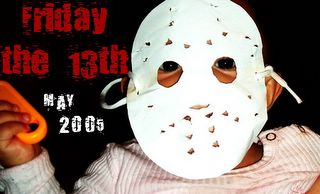Saturday, May 14, 2005
The Inca Empire Trip (12th - 26th March)
Here are some photos from the Inca Empire GAP Tour with Marie, Stewart, Daniela, Johanne, Judith and Jack from La Paz to Lima. Thanks guys for the wonderful time!

At the ancient site of Tiwanaku, Bolivia, with the Ponce monolith looking back through the Kalisasaya gateway.

Marie and the lake Titicaca.

Totora raft ride on lake Titicaca.

Jack and Jude in Chinchero on Palm Sunday.

Peruvian trains are not that big.

The town of Aguas Calientes (or 'Machu Picchu Pueblo') by the Urubamba River.

Jackie up front and Jude in the background, on the second and the scariest ladder leading up to Putukusi.

Sitting on top of Mt. Putukusi, a peak facing Machu Picchu. The serpentine road leading up to the ruins is visible to the left. It took a bit over an hour to hike up here with Jackie (from Toronto, Canada).

Waiting for the train in Aguas Calientes. From left to right: Stewart, Marie, Daniela and Johanne.

Jack shooting in the Valley of the Moon, in La Paz, Bolivia.

A game of football with the islanders of Amantaní.

Palm Sunday in Chinchero. The church on the background was built on Topa Inka's palace, and much of the original stonework is still intact as can be seen in this photo.

Holy Week in Cuzco started with the procession of the 'Lord of the Earthquakes'. The procession culminated in the night after the 'Lord', which is a Christ statue that once allegedly ended a big earthquake in Cuzco, has gone through all the churches is town. By the time it got back to the Cathedral, the whole plaza was totally packed with 'Cuzqueñas', and the Christ all covered in red sage flowers, that people threw down from the balconies.

Aguas Calientes, nowadays dubbed as the 'Machu Picchu Town' as seen from above.

Me and Jackie (who was on another GAP group) on top of Putukusi.

The conquerors of the Lost City of the Incas! From left to right: Daniela, me, Johanne, Jude, Stewart, Marie and Jack.

What a delicious plate of Stuffed Tomatoes!

Jack, Jude, Daniela and Johanne watching the soccer game on Amantaní Island in Lake Titicaca.

Local ladies coming out from the Chinchero Church, built on top of the palace of Topa Inca.

'Lord of the Earthquakes' is brought out from the Cathedral.

Jackie and Jude at the start of the Putukusi Trail.

Jackie hiking up Mt. Putukusi. Behind lies the town of Aguas Calientes.

We were the first people in the morning to walk through the mist-covered ruins of Machu Picchu. Jackie, Jack and Jude cornered by the llamas.

After the Inca Trail in Aguas Calientes.

Last night together in Lima.
Friday, May 13, 2005
Friday the 13th!!!
Voi Itku!
Olihan se Suomi-Venäjä ottelu pakko nähdä. Niinpä edellisenä iltana Miskan kanssa chattaillessa sain idean että jospa ne Mertarannan selostukset saisi netin kautta vedettyä tänne Peruun asti.
Ja niinhän me sitten tehtiin: ensin kokeiltiin Skypeä - nettipuheluohjelmaa, ja toisessa erässä vaihdettiin jo tuttuun messeriin, ilman mainittavaa muutosta äänenlaadussa. Kuvayhteyskin saatiin samalla, vaikka webikameran kautta nähtynä meno muistutti enemmän diashowta kuin livematsia.. mutta sai siitä silti paremman käsityksen missä päässä kiekko milloinkin pyöri.
Ja niinhän siinä sitten kävi, mihin ollaan jo totuttu: huima jännitysnäytelmä ja sitten se antikliimaksi. Ihmiset katoavat tuuttien äärestä hetkeksi huokailemaan, kiroilemaan ja suremaan ja sitten pian keksimään jotain muuta tekemistä jotta koko MM-turnaus saataisiin pyyhittyä lähimuistista. Seuraavan päivän iltalehdet jätetään ostamatta ja YLE:n kanaville luikahdetaan vain pakosta kunnes kisalähetykset ovat ohi.
Minuakin harmitti. MM-huumaa ehdin elää vain muutaman tunnin ja sitten se oli kaikki ohi. Eikä kyse ollut vain jääkiekosta: kiekkolähetys oli niin tervetullut tuulahdus siitä Suomesta jota täällä kaukana eläessä kaipaa, ja sen jakaminen veljeni kanssa niin paljon parempaa kuin tyypillinen kuulumisten vaihtaminen internetin tai puhelimen välityksellä. Olisin toivonut edes muutaman ottelun lisää.. eikä se MM-kultakaan olisi ollut pahitteeksi.
No mutta ei se mitään, vaikkei MM-kultaa tullutkaan, kohta sitä ollaan Suomessa. Liput on jo varattu ja 10.6. Soinin perhe laskeutuu Vantaalle (kunhan ensin on Eiffel-tornit ja riemukaaret käyty katsomassa.. pitäähän ne stopoverit käyttää hyväksi). Suomen kesä, Juhannus, mansikat, sauna, mökki, mummola, sukulaiset ja kaverit - täältä tullaan!!!!!!
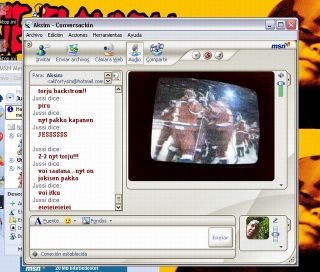
Olli Jokinen epäonnistuu rankkarissaan ja Venäjä jatkaa välieriin.
Saturday, May 07, 2005
The Road to La Unión
The next morning after Silvia and the kids had taken a bus back to Lima, I embarked on my 'expedition' to the ruins of Wanukomarka, or the 'Old Huánuco', above the town of La Unión, on the way to Cordillera Huayhuash. The trip was supposed to take four-and-a-half hours but turned out to be a little more difficult than I thought.
The day was sunny and beautiful. I was seated in the front, sipping on a bottle of 'uvachado' - a local brandy - that had found it's way into my bag from a little stall selling jungle liquours outside the 'Owl Cave' in Tingo María. I think the place was named after another jungle drink, the notorious 'R.C.' or 'Rompecalzón' - the 'pantybreaker'.
Most of these drinks are based on herbal medicines and retain the curing factor but, I guess, the alcohol has been added to make the drinks more attractive to tourists and to the locals that still prefer using them instead of modern medicine. This stall had them all: '7 Roots', '21 Roots', 'Cat´s Claw' 'Sangre de Grado', 'Chuchuwasi', 'Para Para', 'L.P.M' (the last two being cures for impotence, first meaning "Stand up, stand up" and latter is an abbreviation of words that mean "get up dead weenie"), and many more that I can't remember. 'Uvachado' was the only one that was purely alcoholic drink, nothing more.
After two hours of driving, we came upon a group of people walking our way on the road. I saw one of them waiving his finger at us and knew immediately what was going on. Some half-a-kilometer ahead, a landslide had blocked the road completely. There was no bulldozers or roadworkers around so it was clear that the busses will not get through any time soon.
I took my bags, got off the bus and walked to the site of the accident. To mine and everyone's amusement, some people had cleared off some of the landslide and were now trying to pull a small 'Tico' over ('Daewoo Tico' is the car that came to replace the Volkswagen Beatle as the most common and cheapest taxi in the streets of South America.) I stopped for a moment to watch and to my surprise after a tough effort they finally succeeded. One thing was sure: any bigger than that Daewoo would certainly not make it. So I walked on, hoping there's someone on the other side with a transport, smart enough to give up early and turn back. I was lucky and didn't have to wait long.
Half-an-hour from that, I was comfortably tipsy with 'uvachado' and sitting on a bus on the way towards Tantamayo. After some two more hours I jumped off at crossroads and got the last available seat in a small combi, that rode me all the way to La Unión. It was only 2:20 pm and I had made it early enough to still go and visit the ruins of Wanukomarka!
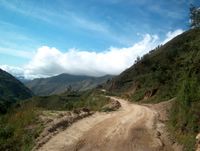 The dirt road from Huánuco to La Unión was, at it's best, bumpy, and often in the rainy season at certain parts impassable. Today was to be one of those days.
The dirt road from Huánuco to La Unión was, at it's best, bumpy, and often in the rainy season at certain parts impassable. Today was to be one of those days.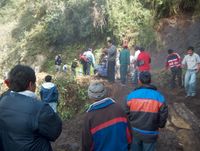 A landslide had blocked the traffic between La Union and Huánuco that day. This 'Tico' was the only vehicle to go through this morning. The bigger trucks and buses would have to wait for the bulldozers. I was smart enough to walk through as quickly as possible and jump into the first bus turning back on the other side, instead of staying around to watch and scratch my head like most of the people here did.
A landslide had blocked the traffic between La Union and Huánuco that day. This 'Tico' was the only vehicle to go through this morning. The bigger trucks and buses would have to wait for the bulldozers. I was smart enough to walk through as quickly as possible and jump into the first bus turning back on the other side, instead of staying around to watch and scratch my head like most of the people here did. The narrow dirt road snaked it's way higher and higher in this little-visited territory that used to be home for the Maoist rebels of 'Sendero Luminoso' - the Shining Path.
The narrow dirt road snaked it's way higher and higher in this little-visited territory that used to be home for the Maoist rebels of 'Sendero Luminoso' - the Shining Path.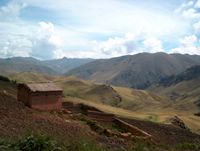 Highlands of Huánuco. The trip to La Unión took six and a half hours in total, with the landslide episode. Still, a bottle of 'uvachado', a local jungle brandy, made it very enjoyable. The sheer feeling of travelling a route that very few travellers ever take, made the trip worthwhile.
Highlands of Huánuco. The trip to La Unión took six and a half hours in total, with the landslide episode. Still, a bottle of 'uvachado', a local jungle brandy, made it very enjoyable. The sheer feeling of travelling a route that very few travellers ever take, made the trip worthwhile.Friday, May 06, 2005
Trip to Huánuco and Tingo Maria April 23th - 27th
Finally went for holidays together with the entire family! Although we were travelling with two kids (Jasmine's cousin Rosa came with us because her mom was working and thus couldn't have looked after her), it still ended up being quite an enjoyable trip!
We started by taking a morning bus to Huánuco. The trip took almost 9 hours but luckily the bus turned out to be one of the most comfortable I've been in for a long while. The road first goes up and over the Ticlio Pass (4850m) to La Oroya, and then branches towards north following the Andes. It passes by Cerro de Pasco (3350m) and then starts a descent into the Huallaga valley, so-called 'Red Zone', that was notorious before as Shining Path territory, and is still strong in narcotrafficking.
Jasmine coped very well with the altitude. She simply slept over the highest part but even on the lunch break at an altitude of 3400m she was happily jumping and laughing.
We arrived in Huánuco where Silvia's cousin, Marita, was soon to meet us. Huánuco (1894m) itself isn't much of an attraction but the climate is perfect. The next day we did a short daytrip to the ruins in Kotosh to visit the Temple of the Crossed Hands which is said to be the 'oldest temple in the americas' dating back 4000 years.
After two pretty eventless days in Huánuco (a name of the town derives from 'guanaco', the wild relative of the llama) we took off towards Tingo Maria. It lies in a region known as Rupa Rupa ("hot hot") that refers to the climate region between the low jungle and the Yungas, about 200 - 500m above sealevel on the Amazon side of the Andes. At least for the Peruvians, who seem to love imaginary shapes anywhere in the nature, Tingo Maria's main attraction is the 'Sleeping Beauty' - a range of hilltops forming the skyline behind the town that resembles a woman lying on her back. This time I have to admit that it did.
We decided to give ourselves a treat and paid a little extra for the best room in the hostel - one with a jacuzzi for $18 - just for one night. It definitely did the trick in the otherwise sweaty little town.
Next morning we started at 9 am with a visit to 'La Cueva de Las Lechuzas', 7 kms away from town. When we were about to leave back, it started raining, and didn't stop until late afternoon. We went back to town for lunch and then drove to see a St. Carmen waterfalls outside of town. When the rain did finally stop, I took Jasmine and followed Silvia and Marita to the waterfall, walking some two-and-a-half kilometers on a slippery path through the forest. After a mandatory splash in the cool pool below the cascade we headed back. On the way back I was lucky to spot a flock of emerald toucanets.
The next day we drove back to Huánuco where Silvia and the girls continued the same night to Lima and I left next morning towards the inca ruins of Wanukomarka and then to Huaraz.
You can read some more about our holiday from Jasmine's Diary.
Here's a couple of photos from the visit to Tingo Maria.
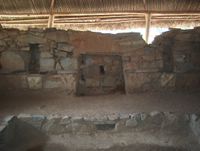 Temple of the Crossed Hands in Kotosh. It is thought to be the oldest temple in South America and is situated a short cab drive away from Huánuco. The hands on the left represent the man and the hands on the right, the woman.
Temple of the Crossed Hands in Kotosh. It is thought to be the oldest temple in South America and is situated a short cab drive away from Huánuco. The hands on the left represent the man and the hands on the right, the woman.
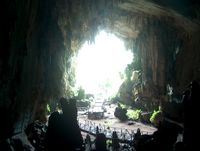 'La Cueva de Las Lechuzas' - "The Owl Cave". A huge, fascinating cave some 7 kilometers from Tingo Maria, is a home to a colony of owl-like 'guacharos', also known as oilbirds. It also hosts a multitude of bats, some weird cave-dwelling insects, and many parrakeets near the entrance. We got here in the morning and were the only tourists around besides one peruvian couple. They pointed us one baby oilbird that had fallen down from above. Our guide told us not to shine our flashlights up to the roof because it causes the poor little ones to jump into their evident death.
'La Cueva de Las Lechuzas' - "The Owl Cave". A huge, fascinating cave some 7 kilometers from Tingo Maria, is a home to a colony of owl-like 'guacharos', also known as oilbirds. It also hosts a multitude of bats, some weird cave-dwelling insects, and many parrakeets near the entrance. We got here in the morning and were the only tourists around besides one peruvian couple. They pointed us one baby oilbird that had fallen down from above. Our guide told us not to shine our flashlights up to the roof because it causes the poor little ones to jump into their evident death.
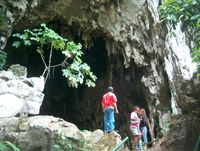 A view from the mouth of the cave. There were many parrakeets and parrots flying around here, and the sounds of the oilbirds (Steatornis Caripensis) echoing from inside were unreal. Oilbirds are a nocturnal owllike species, and called that way because the babies would grow grotesquely fat and this fat was used by natives and early settlers for making torch oil.
A view from the mouth of the cave. There were many parrakeets and parrots flying around here, and the sounds of the oilbirds (Steatornis Caripensis) echoing from inside were unreal. Oilbirds are a nocturnal owllike species, and called that way because the babies would grow grotesquely fat and this fat was used by natives and early settlers for making torch oil.